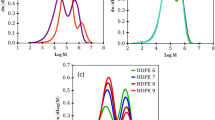Abstract
Linear-viscoelastic properties of polydisperse and randomly-branched polymer melts were fit with several proposed relaxation functions by non-linear regression. Three polymer systems were investigated, including 1) crosslinked polyethylenes, 2) polydisperse linear poly(dimethylsiloxane)s, and 3) Marlex polyethylenes, which are polydisperse and probably contain long-chain branching. Four relaxation functions were evaluated, including the Rouse, reptation, stretched-exponential, and stretched-exponential-power-law (SEPL) relaxation functions. The SEPL best described each series of polymers, and therefore may be a general relaxation function for non-uniform polymer melts. The flow activation energy for crosslinked polyethylene may be coupled to a breadth-of-relaxation index, indicating that a coupling between a characteristic short relaxation time and longest relaxation time, as suggested by Ngai and Plazek (J. Polym. Sci. Polym. Phys. Ed. 1985, 23:2159–2180), may hold for some non-uniform polymers.
Similar content being viewed by others
References
Tschoegl NW (1989) The phenomenological theory of linear viscoelastic behavior. Springer, Berlin
Dealy JM, Wissbrun KF (1990) Melt theology and its role in plastics processing. Van Nostrand Reinhold, New York
Ferry JD (1980) The viscoelastic properties of polymers. J. Wiley & Sons, New York
Doi M, Edwards SF (1986) The theory of polymer dynamics. Clarendon, Oxford
Berry GC, Fox TG (1968) The viscosity of polymers and their concentrated solutions. Adv Polym Sci 5:261
De Gennes PG (1979) Scaling concepts in polymer physics. Cornell University Press, Ithaca
Larson RG (1988) Constitutive equations in polymer melts and solutions. Butterworths, Boston
Graessley WW (1982) Entangled linear, branched and network polymer systems-molecular theories. Adv Polym Sci 47:67
Baumgaertel MA, Schausberger A, Winter HH (1990) The relaxation of polymers with linear flexible chains of uniform length. Rheol Acta 29:400
Ngai KL, Wright GB (1984) Relaxation in complex systems. Office of Naval Research, Arlington, VA
Lee M, Fergusori R, Jamieson AM, Simha R, Cowie JMG (1985) A photon correlation spectroscopy study of poly(di-n-butyl itaconate) near Tg. Polym Comm 26:66
Mezei F, Knaak W, Farago B (1985) Neutron spin-echo study of dynamic correlations near the liquid-glass transition. Phys Rev Lett 58:571
Chamberlin RV, Mozurkewich G Orbach R (1984) Time decay of remnant magnetization in spin-glasses. Phys Rev Lett 52:867
Williams G, Watts DC (1970) The dielectric relaxation of polymers. Trans Faraday Soc 66:80
Ngai KL, Rendell RW (1982) Stress relaxation and loss moduli measurements in linear and branched polymer systems correlated with steady state viscosity: molecular weight dependences. Am Chem Soc Polym, Prepr 23:46
Ngai KL, Plazek DJ (1985) Relation of internal rotational isomerism barriers to the flow activation energy of entangled polymer melts in the high-temperature arrhenius region. J Polym Sci Polym Phys Ed 23:2159–2180
Scanlan JC, Winter HH (1991) Composition dependence of the viscoelasticity of end-linked PDMS at the gel point. Macromolecules 24:47–54
Scanlan JC, Winter HH (1991) The evolution of viscoelasticity near the gel point of endlinking PDMS. Makromol Chem Macromol Symp 45:11
Scanlan JC, Hicks MJ (1992) The evolution of linear viscoelasticity of PE during vulcanization. Rheol Acta, in press
Martin JE, Adolf D, Wilcoxon JP (1988) Viscoelasticity of near-critical gels. Phys Rev Lett 61:2620
Hess W, Vilgis TA, Winter HH (1988) Dynamical critical behavior during chemical gelation and vulcanization. Macromolecules 21:2536
Stauffer D (1985) Introduction to percolation theory. Taylor and Francis, London
Stauffer D, Coniglio A, Adam M (1982) Gelation and critical phenomena. Adv Polym Sci 44:103
Ogielski AT (1985) Dynamics of three dimensional ising spin glasses in thermal equilibrium. Phys Rev B 32:7384
Bontemps N, Orbach R (1988) Evidence for differing short- and long-time decay behavior in the dynamic response of the insulating spin-glass EuSrS. Phys Rev B 37:4708
Adolf D, Martin JE (1990) Time-cure superposition during cross-linking. Macromolecules 23:3700
Booij HC, Thoone GPJM (1982) Generalizations of the Kramers-Kronig transforms and some approximations of the relations between viscoelastic quantities. Rheol Acta 21:15
IMSL (1989) IMSL User's Guide. IMSL, Inc., Houston, TX
Gradshteyn IS, Ryzhik IM (1965) Table of integrals, series, and products. Academic Press, New York
Author information
Authors and Affiliations
Rights and permissions
About this article
Cite this article
Scanlan, J.C., Janzen, J. Comparison of linear viscoelastic constitutive equations for non-uniform polymer melts. Rheola Acta 31, 183–193 (1992). https://doi.org/10.1007/BF00373240
Received:
Revised:
Issue Date:
DOI: https://doi.org/10.1007/BF00373240




